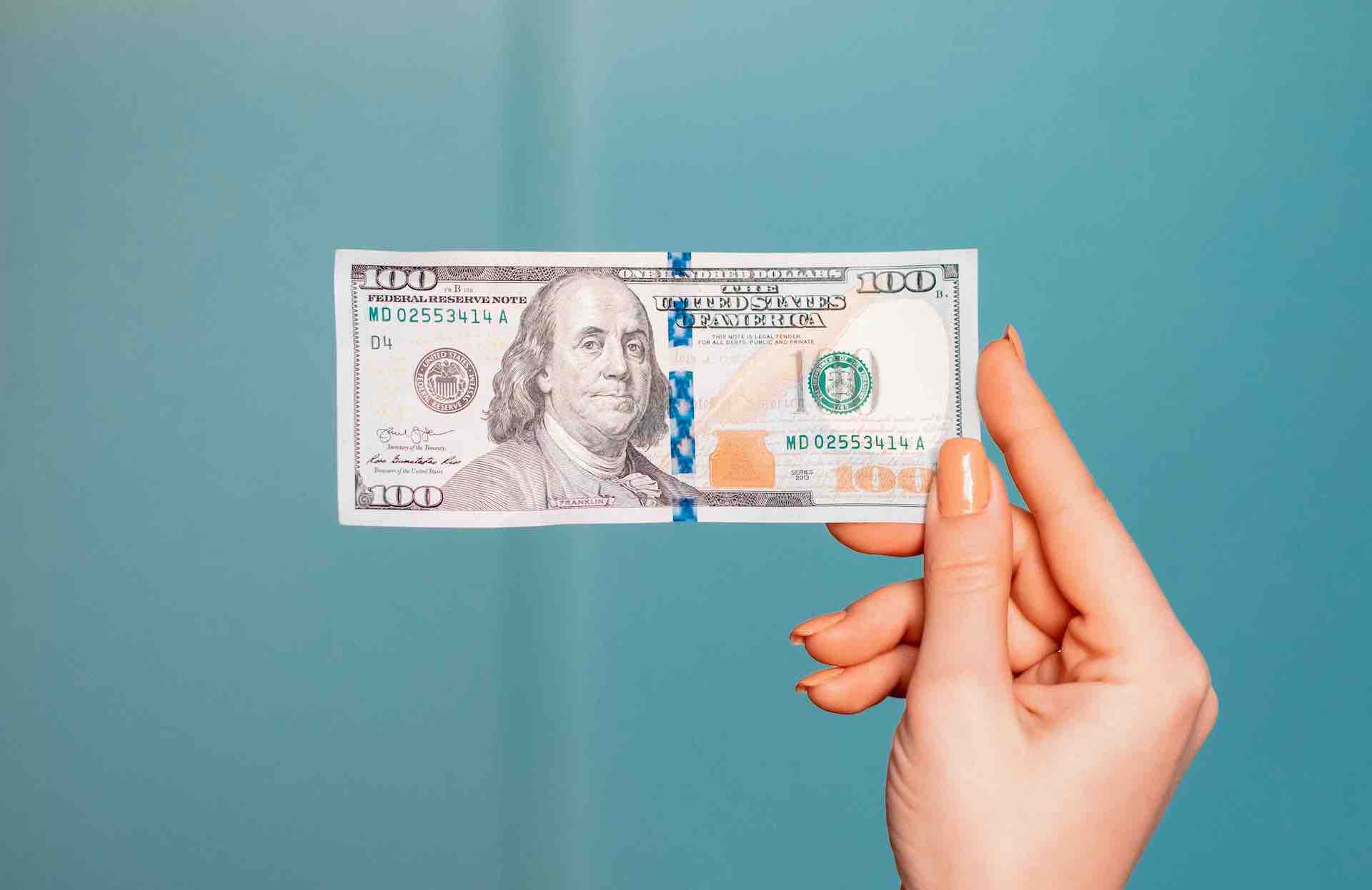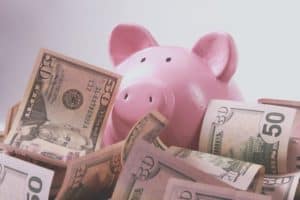How to Do a No-Spend Challenge and CRUSH Your Money Goals

This post may contain affiliate links. If you decide to purchase through my links, I may earn a small commission. Read my disclosure page for more info.
NO spending. Sounds scary right?
It’s almost like saying “no breathing” or even worse: “no Netflix”. Aaaah! Okay, maybe that’s just me.
But the truth is, a no-spend challenge is something everyone can do and should do every once in a while.
Why?
Because no-spend challenges can help you reach your financial goals and completely transform your relationship with money.
So today, I want to show you exactly how to do a no-spend challenge and set yourself up for success, so that you can crush your money goals.
Related Read: 21 Things I Stopped Buying to Save $100k
What is a no-spend challenge?
In a nutshell, a no-spend challenge is where you stop spending money for a certain period of time.
And who doesn’t love a good challenge?? Think: spicy wing challenge at your local bar, but without the tears running down your cheeks and your insides being on fire.
I’d say a no-spend challenge is a hell of a lot easier than that, but then again even Flamin’ Cheetos are too hot for me.
For your no-spend challenge, you can challenge yourself to not spend money on any items or just on certain things (more on this later).
As well, your no-spend challenge can last for however long you’d like it to, whether that’s a day, a weekend, a week, or a month! YOU set the rules!
What are the benefits of a no-spend challenge?
No-spend challenges are becoming very popular as more and more people realize the numerous benefits to this exercise.
I’ve done a few challenges, but my most recent one was for a month and I wasn’t allowed to buy anything from Starbucks.
Want to know how much I saved?
$112! That more than covers my monthly digital subscriptions! Now that’s a testament to the power of no-spend challenges…or, my embarrassing addiction to Starbucks.
Side note: Now I take advantage of ways to get FREE Starbucks drinks! I can keep sipping and still save.
If $112 doesn’t seem like a lot, think about the long-term benefits to going a month without spending on a particular item. You end up realizing that you don’t need it as frequently and/or that there are in fact better, cheaper alternatives. As a result, your spending habits adjust and you save a lot of money in the long-run!
And most importantly, you recalibrate your relationship with money. You’re forced to be more mindful of how and what you spend, and this mindset lingers long after the challenge is over.
It’s hard to list all the benefits you’ll get by doing a challenge, but here are some of the biggest and best perks to a no-spend challenge:
- to save money
- to build a rainy-day fund
- to put money towards debt
- to find creative and frugal solutions to expenses
- to stay on budget
- to reset your relationship to money
- to conquer certain bad-spending habits
As you can see, a no-spend challenge can help you reach your financial goals, no matter what they might be or whether they’re short, medium, or long-term ones.
Related Read: 75 Easy Frugal Hacks to Save BIG

How to do a no-spend challenge.
So now that you’re ready to take on the challenge, it’s important that you don’t rush into this and try to nix purchases cold-turkey.
To do this the right way, there are key steps you should follow so that, in the end, you’re successful.
1. Figure out your “why”.
Just like in budgeting, you need a reason to stay motivated along the way and achieve your goals. In other words, you’ll succeed if you have your eyes on the prize.
So first, you need to ask yourself: What’s your prize?
Is it to:
- save up a rainy-day fund
- save for Christmas gifts or other sinking funds (birthdays, special events, holidays, etc.)
- kick a certain shopping addiction in the butt (Starbucks, Amazon, or Target, for example)
- cut back on food expenses
- save up an emergency fund
- eat way at your credit card balance
This list of possible reasons are endless!
Whatever your “why” is, write it down somewhere. Post it in a place where you’ll see it regularly, for example on your fridge or mirror, so that you stay focused.
There’s nothing better than reaching the end of a no-spend challenge, making strides towards your goal, and accomplishing what you’ve set out to do.
2. Make sure everyone is down for a no-spend challenge.
If you’re single, DON’T skip this step!
By everyone, I mean everyone you regularly socialize with, live with, or love!
Let’s face it: sometimes our friends can be bad influences.
We’ve all had moments where we were on-track with our monthly budget, and then someone arranges a get-together for X reason, and next thing you know you’re on your sixth beer and heading to bar number 3 for the night.
You need to tell your friends about your no-spend challenge so that they too are on board.
Better yet, see if one of your friends wants to do a no-spend challenge with you! It’s nice to have someone else participating with you so that you can keep each other motivated.
And if you’re in a relationship, telling your partner is a given.
Chances are, you have shared expenses that’ll need covering and prepping that needs doing before you can start a no-spend challenge. Doing this together is the best option here, as one of you won’t tempt the other to spend money.
Related Read: How to Live Frugally on ONE Income
3. Decide on a timeframe for your challenge.
There are a few options here and it’s important to be realistic about what you can achieve. You don’t want to set an impossible goal for yourself, set yourself up for failure, and not reap the rewards of your no-spend challenge.
The right timeframe for you will depend on your lifestyle, your “why”, and what you think is achievable.
Here are the most common no-spend challenge timeframes as well as some “fine print” you should think about for each.
- No-spend day — This is the best way to get started if you’re new to this challenge, and because of the short timeframe, you should aim to not spend on anything. You’d be surprised how difficult it actually is to not spend money for an entire day! You’ll need to make sure you have gas in the car and food in the fridge, so as to avoid those expenses. But other than that, no-spend days are a great way to refresh your finances!
- No-spend weekend — With each additional day, the challenge gets harder. However, newbies can do this one as well as seasoned no-spenders. You can do it on a Saturday and Sunday, or opt to include Friday into the weekend and not spend for 3 days. I’d recommend being realistic about your necessary expenses on the weekend and not aiming too high. That being said, if you plan ahead you can set some fairly strict rules for your weekend no-spend challenge.
- No-spend week — Once you get up to a week of no-spending, you should be more lenient and incorporate necessary expenses into your challenge. I’d recommend allowing yourself food and gas purchases, as well as obviously any fixed monthly expenses (rent, mortgage, utilities, etc.) that are due. No-spend weeks are great for cutting certain shopping addictions and cutting bad spending habits!
- No-spend month — This is for the seasoned no-spenders only! I’d strongly suggest that you do a few no-spend weeks (not necessarily back-to-back) to see how it feels and test your motivation. Again, you don’t want to fail; the goal is to succeed! No-spend months are great for cutting spending on particular items. You’ll have to spend money on fixed expenses, like food and gas, for example.
4. Set the rules for your no-spend challenge.
The timeframe you choose will determine the rules you set and vice versa.
Again, the longer your no-spend challenge is, the looser your rules will probably have to be.
Here are some questions to help you plan, as well as some suggested items to nix during your challenge.
Can you spend money on anything?
- Zero-spending — As the name suggests, this means you cannot spend money on anything. This is only recommended if you’re doing a no-spend day or weekend. If you’re going with this option, you can skip to the next step because there’s only one rule: NO SPENDING!
- Spending only on necessities — This is where you stop spending on certain things, but allow yourself to ONLY spend on necessities, such as your non-negotiable expenses like rent, mortgage, utilities, essential food, and gas.
- No spending on certain items — This one is the most flexible, depending on how many items you add to the no-spend list. Using this method, you can definitely do a no-spend month and stop spending on work lunches, for example, or Starbucks like I did. Again, you pick the items; you set the rules.
What CAN you spend on?
You’ll need to spend money on certain necessities if you’re going longer than a weekend. These are some non-negotiable items to get you thinking:
- rent or mortgage
- essential food items
- insurance
- gas
- any other fixed, non-negotiable monthly expenses
What will you NOT spend on?
Here are some ideas of things that you can cut during your challenge:
- eating out
- clothing
- impulse buys
- Target (it’s an addiction)
- Starbucks (very much an addiction)
- Amazon (it’s just too easy to spend)
- Your favorite online retailer (Modcloth, how I love you!)
- books (but…but…oh, okay)
- any other far-too-frequent purchases
Related Read: 11 Clever Hacks to Get FREE Starbucks Drinks
5. Plan ahead.
You know why you’re doing this, you’ve got everyone on board, you’ve picked a timeframe and set the rules…but there’s still more planning to do!
- Check the calendar. Don’t plan your no-spend challenge over a friend’s birthday weekend or during a week with a lot of special events. Ideally, your challenge will be during a time period where you’ll mostly be at home. You want to choose your date(s) wisely and rid yourself of as many temptations to spend.
- Meal plan and prep food. If you’re cutting out restaurant expenses or doing the zero-spending method, you’ll need to make a meal plan for your dates and prep your food in advance. Hopefully you’re regularly meal-planning already, as it’s one of the frugal-est (made that up) things you can do. But if not, sit down and write out what meals you’ll eat each day and then make your grocery list based off that. Buy and prep these things a day or two before, and you’re all set.
- Put the credit cards away. Throw them in a drawer and out of sight. Having your credit cards close by will tempt you to spend money, especially online!
- Stay away from your favorite online shopping sites. Connected to the last point, but take it a step further and don’t even visit those websites! All of us have opened up an online retailer’s site, with only the intention “to look”, but then immediately fallen in love with an item “that we must have”. Stay away!
- Plan free activities and entertainment. If you’re used to spending money on movie tickets at the weekend or going for coffee with friends, you’ll need to plan out free activities you can do instead. Introverts, we’re pretty good at finding free things to do at home, but it might be a struggle if we’re doing a no-spend week, for example.
Just in case you need some ideas for free activities/entertainment, here you are:
- Be in nature. Go for long walks at your local park or even camp in your backyard!
- Hobby on. Now’s the time to hobby like you mean it. Play all the games (you already own), read all the books (that are gathering dust on your shelf), and knit that sweater you’ve been wanting to.
- Host a game night. Have people over for a board games, party games, card games, or video games night! Make it BYOB 😉
- Go screen-free. Enjoy your no-spend day or weekend going screen-free! Try to limit your phone use and instead journal, read, use conversation starter questions, etc.
- Do yoga. No explanation, just do it. It’s free, you can do it at home, and it’ll help you be more mindful in all areas of life, even finances!
- Have a movie night. Pop some popcorn, dim the lights, and press play on a movie you and your friends will enjoy. Go for a themed movie night, like “Wine and Superman” or “Marvel and Munchies”…I’m just making these up, although that last one sounds brilliant.
- Host a “take our shit” party! This is one of my favorites. Have colleagues and friends over for some drinks, games, or a movie…BUT have a box of things that you no longer want ready to go. Let them choose anything they want from the box to take home! It’s a great way to recycle things, declutter your space, and give others things they may need!
- Do a swap/exchange with friends. Have everyone bring items that they no longer want and do a swap/exhange! You can swap:
- clothing
- books
- board games
- video games
- craft supplies – paints, yarn, patterns, ANY crafts/DIY supplies that you have laying around that you never use but a friend might want!
- ANY other hobby-related items
- Be productive. With any free-time you have, use this time to work towards other important tasks that need doing. For example:
- Set your short, medium, and long-term financial goals.
- Create a budget or adjust the one you have.
- Start a side-hustle so you can increase your monthly income.
Related Read: How to Save Money on Hobbies (Without Giving Them Up!)
6. Don’t punish yourself during your no-spend challenge.
If you “break the rules” and make one or two purchases outside of what you’ve allowed yourself, don’t punish yourself and quit altogether.
Remember, the goal of a no-spend challenge is to make us more aware of how and what we spend our money on. This is where the old saying “old habits die hard” really applies!
Just by doing a no-spend challenge, you’re already making strides towards improving your relationship with money and how well you manage it. The fact that you’re trying this out is a huge win, in and of itself. Be proud!
7. Keep a wishlist.
Especially for those of you tackling the “zero-spending” or “spend only on necessities” challenge, it will be really difficult to avoid temptations.
To redirect your impulse to spend, create a wishlist of things you might like to buy at the end of your challenge.
Now, this isn’t to say that a no-spend challenge should just delay buying something, because then there would be no savings and therefore no point!
But by making a wishlist, you’re (kind of) following the “72-hour rule”, one of my favorite frugal hacks to save money. You’re waiting a certain amount of time before you buy something.
Just by waiting a little bit, you’ll likely find that you don’t actually want or need that item, and discover that you were about to impulse buy! A wishlist can help you avoid this and give you more time to decide if something is worth purchasing.
Related Read: 21 Extreme Frugality Tips to Save $1000s!
8. Done? Now put your savings towards your goal(s).
You’ve reached the end of your no-spend challenge! Woohoo! It’s important that you really make a celebration of this. Take a moment to congratulate yourself and give yourself a literal pat on the back. You did it!!
Whether it was a no-spend day, weekend, week, or month, you now have some cash saved, and it’s time to put that money towards your “why”.
If your “why” was to finally start your rainy-day fund, then head straight to the bank and deposit that money into your savings account. Or, go online and transfer the amount right away.
You need to put that money towards your goal immediately, so that you can actually see the awesome results of your no-spend challenge!
9. Assess how you did during your no-spend challenge and plan for the next one!
Now take some time to reflect on your challenge. Ask (and answer) some questions that’ll help you do another no-spend challenge better and more effectively.
Really think about and ask yourself:
- Was the challenge too long or too short?
- Were my rules too strict, too loose, and/or slightly unrealistic?
- What were some things I didn’t plan on or prepare for that would’ve helped me be more successful?
- Did I have enough support from friends, family, and/or my partner? If not, how can I communicate those things to them?
Final Thoughts
No two no-spend challenges are the same.
We’re all striving for different financial goals, calibrating and re-calibrating our unique spending habits, and reaching financial freedom in our own way.
But understanding and improving our money mindset is one of the best ways to ensure we get there.
No-spend challenges are just one way we can learn to live more frugally, reduce our spending and consumption, and improve our overall well-being.
For more money saving tips, make sure to sign-up for my newsletter, so we can keep ourselves motivated and always moving forward. 🙂
For more ways to save money, check out these articles:
- 75 Easy Frugal Living Tips to Save Money Now!
- Amazon Direct Ship Ultimate Guide: Get FREE Stuff Delivered to You
- 11 Simple Steps to Create a Budget THAT WORKS!
- Rainy Day vs Emergency Fund: What’s the Difference and Why You Need Both!
- How to Save Money on Hobbies (Without Giving Them Up)
- Gross Pay vs Net Pay: How to BUDGET the Right Way






